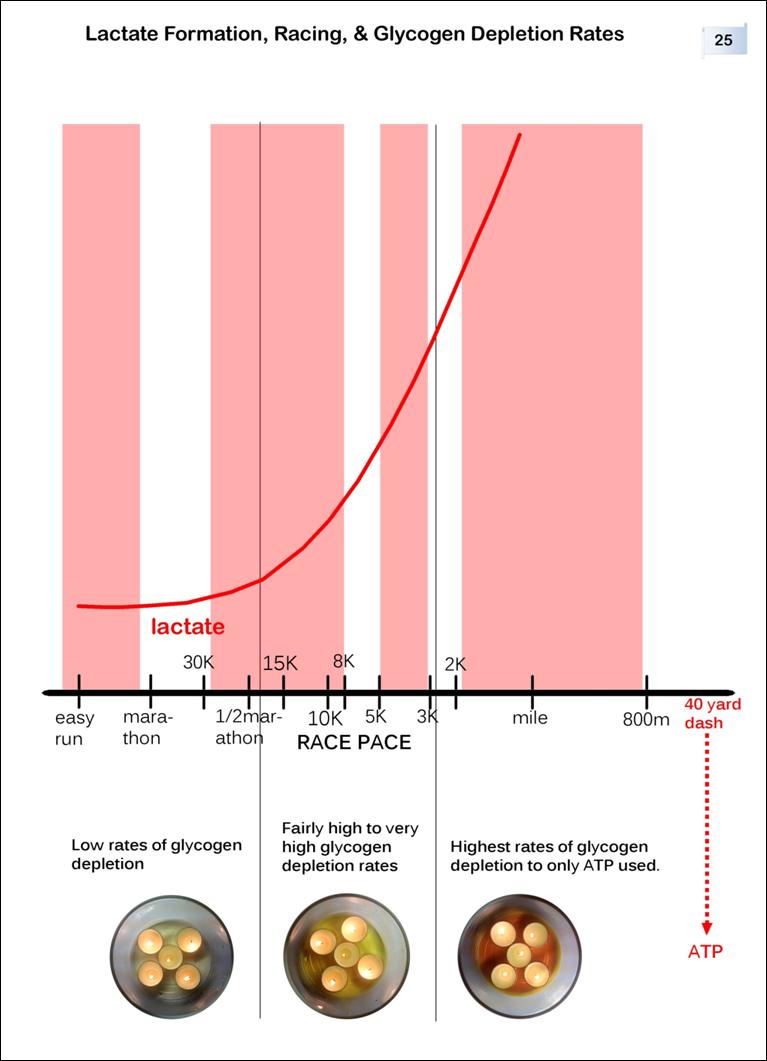
Introductory Video Lesson: Image Imprinting
The fast pace and quick transitions in this video purposely give you little time to process the meaning of some of the images. The deliberate use of this technique is related to a clinical psychological term called imprinting. I don't want you to think, I want you to 'see'. Do not pause the video the first time you watch it. Proceeding this way is exactly how a musician, skilled baseball hitter, NFL quarter back, or an infant develops pattern recognition, processing speed, and cognitive reasoning. Good coaches and teachers know the value and conditioning effects of 'practicing fast' in order to 'see' or perform fast and know when to slow things down. To move your muscles 'fast' and explosively you must play, practice, and train fast. Your brain works the same way. Don't think, just watch the video. Thinking, slowing down, and discussion come later. Prepare your questions for the next lecture.
Forward: Hardly anyone thinks of nutrition as an event in concrete terms. However, people unconsciously speak of metabolism as an event that has a concrete outcome such as weight gain, weight loss, or recovery from training or illness. Such 'metabolic outcomes' occur because nutrition is an active event.
The way to 'see' or visualize nutrition as an active event is to
view images that freeze time and capture a moment of the micro and macro world.
For
example, the two physical phenomena shown
below occur simultaneously; one occurs unseen at the microscopic level
and the other macroscopically, as seen by the naked eye. More
specifically, movement of your whole body (sprinting) and
an unseen metabolic event in your muscle cells (fermentation) occur simultaneously. You would never know this unless you were shown
the connection.


In the first lesson,
color codes train you to see 'metabolism of nutrients' in a muscle cell, akin
to learning the meaning of colors and symbols of a map legend. Let us start from the beginning.
Lesson 2: The Magus of Metabolism
Lesson 4: Muscles, Lightning, Brain Cells, and Water
Lesson 7: Messages from Masters of Nature, Science, and Economics
Source and/or Suggested Readings
Lesson 1: Muscles, Bacteria, and Acid
Food is used within two sections of your muscles. One section is represented by lighted votive candles and the other by yellow food colored water outside of the candles. For now on I refer to all circular images as muscle cells.

Varying the shade of yellow coloring outside the candles indicates the amount of carbohydrate a muscle uses. Darker shades of yellow indicate a muscle uses progressively more carbohydrate as exercise intensity increases. Therefore the muscle cell on the right is using more carbohydrate and working at a higher exercise intensity compared to the muscle cell on the left. The next section shows a real life example.

Compare world class sprinters
running a 100m dash to a girl riding slowly on a bike. Obviously the girl’s legs work at a
much lower intensity compared to the sprinters. We should, and indeed do see a
lighter shade of yellow (outside the candles) in the girl’s muscle cell.
Therefore this color code tells us she is using less carbohydrate to produce
power.

Physical
movement, including healing and regeneration of your body is powered by cells
‘working’ and consuming food. Cells consume food as they work even when movement is not involved.
Before you were born, all your cells ‘worked’ to create you, beginning with the
division of two cells. The food your mother ate fed your cells; now you must
eat to generate movement and to regenerate your cells and whole body.

Exercise
physiology examines how the body uses food while resting, not just during
exercise.
Cells continue working while ‘we appear to be resting’, so we must consider
resting as part of the ‘whole working picture’ just as we consider a car engine
at idle or a woman sitting in a tree both consume fuel. The whole picture spans
the entire ‘energetic spectrum’ of human movement, from rest to maximum
intensity levels.

Similarly to
an idling engine, a developing fetus or meditating woman’s cells never stop
consuming food and producing waste; acid is just one waste product produced
24/7.
Notice in the muscle cell below I wrote “carbs
convert to acid in cytosol”. Cytosol
is the proper name of the outer section. The cytosol of your muscle cells can
use only carbohydrate as fuel. Fat can’t burn in this section of your muscles.

Acid production increases slowly as exercise intensity or speed increases from resting, but then skyrockets exponentially at a certain point. The graph below shows lactic acid increasing as exercise intensity increases.

Similarly to muscles, bacteria living in your intestines convert carbohydrate to acid. Keep in mind, muscle metabolism produces only one type of acid - lactic acid.* Conversely, gut flora produce a variety of other acids, including lactic acid and a small amount of alcohol and nail polish remover (acetone). The image below shows a variety of acids produced within the guts of cows and humans. Comparing cows and humans reveals much about energy intake, weight gain, antibiotics, immunity, and more (examined later).

As muscles and bacteria consume carbohydrate at a higher rate, acid is simultaneously produced at a faster rate. Thus, darker shading in each illustration indicates two things. 1: quantity of carbohydrate converted. 2: quantity of acid produced.


Naturally, it’s stupid to sprint
without breathing, but the point is you can. Holding your breath does not
prevent you from rising out of your chair and sprinting for 20 yards or performing
a 6-rep set of deadlifts. I am NOT saying other parts of your body no longer
use oxygen during high powered exertions. I am saying the cytosol of the
specific muscles producing anaerobic power during sprinting or lifting heavy
weight do not use oxygen, by principle. This ‘power principle’ explains why
white meat is white compared to dark meat in animals like chickens. The ‘white’
muscles are the fast twitch muscles geared for the most explosive movements,
when no oxygen is necessary to move. For example, a chicken uses its white
breast muscles very intensely and briefly during ‘fight or flight’. This
intense power output requires fermenting carbohydrate.
Dark meat is ‘reddish’ because it contains more myoglobin. Myoglobin is
a red, oxygen-binding pigment within slow twitch muscles that gears these
muscles for uptaking lots of oxygen and endurance activity. Chicken breasts
obviously lack this protein, whereas chicken legs contain plenty. Therefore a chicken’s leg muscles
use more oxygen compared to their breast muscles and ‘endure’ working for long
periods of time (allowing for hen pecking), but cannot contract as explosively.
In short, using oxygen allows muscles to work longer, but not explosively.
Using oxygen to produce movement =
aerobic metabolism = oxidative metabolism.
Not using oxygen to produce movement
= anaerobic metabolism = fermenting carbs into lactic acid.
Using oxygen to produce energy results in slower,
less explosive movement compared to fermenting carbohydrates. Moving without utilizing oxygen is
the exclusive domain of very high intensity exercise, e.g. weight lifting and
running 1500 meter races or shorter distances at competitive speeds. High powered, anaerobic events deplete
greater amounts of carbohydrate compared to all slower and less intense
movements. This explains why ‘high carb’ diets are inappropriate for people who
exercise less or exercise at lower intensities. See graphs
in Lesson 25.

Anaerobic ‘work’ applies to ALL
cells of the body, not just muscles. It
just so happens we ‘see’ muscles work because they are specialized cells which
contract or physically shorten as they transform food into movement.
Comparatively, other cells - e.g.
brain, kidney, ovary cells - do not contract as they ‘perform work’. It is
important to know, either anaerobic or aerobic metabolism implies the
production of power, energy, or work within all cells, but ‘power and work’ in
most cells do not create movement.
Muscle cells are one of a kind; they
are a gateway for understanding how all cells work for two reasons:
One: All cells operate similarly. They
feed aerobically or anaerobically. Two:
Muscles cells are the only cells we can relate to in a concrete sense because
we see and feel what they do. We command muscle cells at will. People of all
ages relate to physical control and palpably sensed experiences, thus making
muscle cells the ideal model for teaching nutrition, biochemistry, and more.
It is practical to imagine the
cytosol of a muscle cell as essentially identical to anaerobic bacteria or just
consider it the ‘bacterial section’ as indicated by a student’s hand drawing
below. Now consider
the fact your intestinal tract is oxygen deprived. This mean anaerobes living
within your gut have no choice but to break food down in a way that does not
involve oxygen, if they are going to
survive. Because feeding anaerobically is ‘their only choice’ they possess
machinery designed to ‘eat’ only carbohydrate. Likewise, cytosol of your
muscles cells ‘possess machinery’ to feed only anaerobically.

In short, gut bacteria and cytosol are
anaerobic digesters. Both convert
carbohydrates to acid using the same chemical reaction, namely fermentation. Humans control the fermentation
rate in muscles by voluntarily working harder and/or faster. In other words, we
make our muscles ‘eat carbohydrates’ either slowly or quickly! The fermentation
intensity within the gut is determined by the population density and sheer
numbers of bacteria and not by their individual ‘speed of eating’.
Up to this point, we have ignored
and will continue to ignore the section of a muscle cell that uses food and
oxygen, represented by candles.
Deliberately focusing only on the cytosol and acid production forced you to
unconsciously disregard other ‘nutritional options’ available to a muscle cell.
You were ‘forced’ to see: movement
powered without oxygen occurs solely from the conversion of carbohydrates into
lactic acid.***
Lesson 2: The Magus of
Metabolism: Frances G. Benedict
Part I: ‘Forcing’ or
Magician’s Choice
By choosing to focus on the cytosol,
I ‘forced’ you to examine only one way muscle converts food into power, namely
anaerobically. I
purposely ignored the candles, which represent the section in muscles for
producing aerobic power. Except for comparing white meat and dark meat, all
talk focused on the ‘anatomical space’ where fermentation occurs. Either way
you visualize rate of fermenting carbs and exercise intensity below, lactic
acid production increases sharply within muscles only when we ‘shift’ into very
high exercise intensities.

You have undoubtedly experienced the
buildup of lactic acid when working hard and/or fast, which forced you to slow
down and ‘catch your breath’. Let’s assume you already know oxygen exists,
aerobic metabolism requires oxygen, and fat is a caloric fuel source. Knowing muscles produce the most
intense bursts without oxygen/breathing, you are forced to conclude slower,
less powerful, sustainable movements must involve a ‘nutritional reaction’
involving oxygen and fat. Since only carbohydrate can be used within the
cytosol, this means the ‘oxygen-based nutritional reaction’ must happen
elsewhere within the muscle cell. The candles must represent the anatomical
space where aerobic metabolism occurs and the only place fat burns. There are
no other choices to consider; you have been forced to these conclusions.
The words ‘anatomical space’ refers
to an actual body part, similar to your nose or ear. Only two anatomical spaces exist
for producing movement and metabolizing food, the cytosol and the ‘other
space’. The other space is called the mitochondria.
To a
professional stage magician, forcing is a technical term that means “the
magician verbally forces the item which he wanted the spectator to choose.” This
technique is also known as ‘magician’s choice’ – implying this writer could
have chosen to examine both sections of the muscle responsible for producing
power and movement, but I chose only one, namely the cytosol. Google ‘forcing magic trick’ or click Equivocation
(magic).

Read more on Benedict, The Magus of Metabolism:
http://www.sportsci.org/news/history/benedict/benedict.html
http://www.whonamedit.com/doctor.cfm/3319.html
The graphic below illustrates the
two choices or ‘Two Ways to Produce Energy’ within cells. The blue text in the left column
lists all aspects of ‘nutrition as an event’ during anaerobic exercise. I
deliberately ignored events related to aerobic metabolism listed in the right
column, and will continue to do so until we examine oxidative/aerobic
metabolism. It may now appear obvious that most everything on the right could
be deduced after learning the phenomena listed in the left column. Notice,
‘CARBS ONLY’ at the bottom of the left column indicates it is the only fuel
used to produce anaerobic power. The ability to measure CARBS USED as energy
enables us to calculate and eat a properly ‘balanced amount’ of carbohydrate.
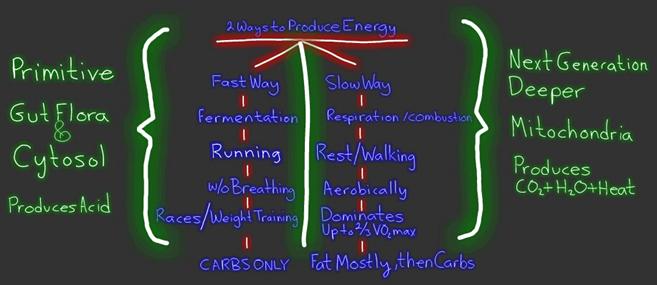
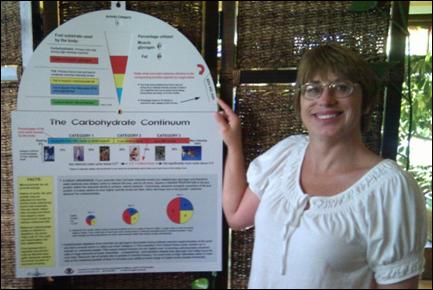
Consider this
quote from Francis G. Benedict, from the preface of the 1906 book by Atwater
& Benedict:
“The study of the transformations
of matter is rendered more complete and intelligible by a knowledge of
transformation of energy.”
It should be
obvious that any nutrition program that does not match nutrient demand to the
whole energetic picture is, by design, limited, stunted, or partial. Telling
people to ‘eat a balanced variety of foods’ may not prevent disease or promote
health because such recommendations do not account for how the body selectively
uses nutrients - unless like a stopped clock, which tells correct time twice a
day, a ‘lucky match’ occurs. The construction of the food pyramid and the Unified
Guidelines of Nutrition resembles a stopped clock. Vague language and failure to quantify
nutritional requirements specifically to the body’s physical demand exposes the
problem of using a one size fits all approach to educate the public. (See
“Creators of Guidelines of Nutrition” in the appendix of The Physical Rules.)
Politicians,
policy makers, and lackey scientists consider a splatter ‘buckshot’ approach
applicable for the masses, but this fails to satisfy an individual who desires
to eat according to function, training goals, or specific healing modalities. The ‘limited
nutritionist’ is satisfied with covering the bases and running a narrow path
around the infield diamond, but the wholistic thinker, trainer, or healer
covers the whole field. He or she thinks in terms of systems and functional
relationships.
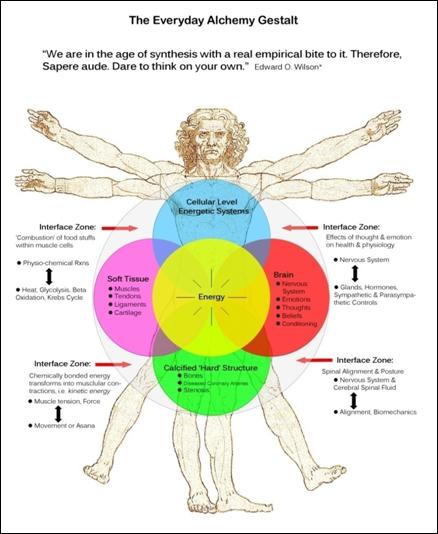
Summarily,
eating nutrient dense foods according to guidelines increases the probability
people may ‘cover the bases’ but this approach is still a crap shoot in terms
of eating based on functional physiology or energetic demand. Following
guidelines accompanied with the intent to prevent disease falls short of higher
thinking, namely eating and training to
promote health and regeneration. Trying to merely avoid disease is not the
same as the expressed intent to promote health on a number of levels. This is
akin to a golfer visualizing a tree and thinking, “Don’t hit the tree” just
before teeing off. Working to avoid disease doesn’t mean you are doing what you
need to do or eating what you need to eat to promote health and regeneration.
You cannot know this unless you examine how your body uses nutrients in terms
of energy and energetic relationships.
A wholistic,
physics based ‘energetic model’ exposes wrong thinking expressed by ‘experts’
who have not been trained to think in terms of functional physical
relationships. All this becomes clear through lessons on exercise physiology,
which includes biomechanics, anatomy, and biochemistry.
Fortunately,
a magician faces little to no resistance in ‘forcing a thought’ upon the
audience, since most people possess no ‘magic knowledge’ and/or have nothing
personally at stake regarding the outcome of someone applying the ‘science of
magic’.
The opposite is true when it comes to teaching the science of nutrition or
applying exercise techniques. People hold deeply rooted beliefs, practice
ingrained habits, and certainly do care about outcomes; resistance is common. So naturally, pointed questions tinged with
disbelief often arise in peoples’ minds after their assumptions are challenged
by factual statements such as, “fat is
the primary fuel for the body at rest and during low to moderate exercise
intensities”. Weight resists your movement, so why shouldn’t thoughts that
challenge yours have a similar effect on your thoughts? Challenging assumptions is a hallmark of
effective teaching.
Accordingly, I deliberately create
phrases to challenge assumptions or ‘force’ concepts that may sound
counterintuitive, but are irrefutable facts, such as:
“Cardiac output is identical in
trained athletes and couch potatoes (untrained humans) at virtually all
intensity levels.”
Shown in frame 1, below left.
Frame 2: “Fat is the primary fuel for the
body at rest and during low, moderate, and moderately high intensity levels.”
Frame 3: “Training does nothing to improve
one’s ability to increase cardiac output or increase oxygen consumption.” (This
applies to any given intensity level except maximum intensity, which is
unsustainable.)
Frame 4: “Fat is the main fuel for the
heart.” A strong and therefore healthy heart utilizes fat as its main fuel. As
it begins to weaken and fail, carbohydrate replaces fat as the primary fuel.
But progressively toward failure, each fuel is used less and less.

All the statements above are simply
straight talk that people are not used to hearing. Dealing with perception is
paramount. Providing a different perspective for people – as opposed to spoon
feeding them with cliches that conform to expectation – stirs the thought pot
and invites pointed questions. Posing a challenging question or statement
ferrets out people’s beliefs, which helps both teachers and students clarify
thoughts and identify where a ‘disconnect’ exists with respect to integrating
parts within a whole. Schematics and visual props enable people to visualize
connections among the parts of the whole.
Understanding the connections between food and energy production is made
possible by matching ‘activity’ of unseen metabolic events in muscle
cells to the simultaneous movement of the whole body. But even this technique is limited; and
this limitation points to the value of the next lesson.
Lesson 3:
Expand Your Limits - Look to Phenomena in Nature to Understand the Body
We, as scientific investigators,
observe phenomena ‘not of the body’ to explain the identical physical event occurring
within the human body. For
example, the
yellowing in the image below resulted from a free radical chain reaction, which occurs readily
to unsaturated fats in both food and
in your body. The yellow stuff shows how unsaturated
fat in soybean oil (in a blob of fresh bleu cheese dressing) reacted with
oxygen. This oxidative reaction turns oils such as flax-seed or
fish oil into wood varnish. This reaction is equivalent to ‘the chemistry of
aging your skin’, the ‘free radical chain reaction’, or ‘suppressing your
immune system’. Unsaturated fats are the type of fats which, by definition make
whole food fats oxidatively unstable, and make LDL cholesterol dangerous in
terms of increasing risk of coronary heart disease, (not saturated fats). The
‘classical’ lipid-heart hypothesis is not supported by evidence; it is a
falsehood that has become a myth. A myth is not necessarily invalid information
or untrue, but many falsehoods become myths.
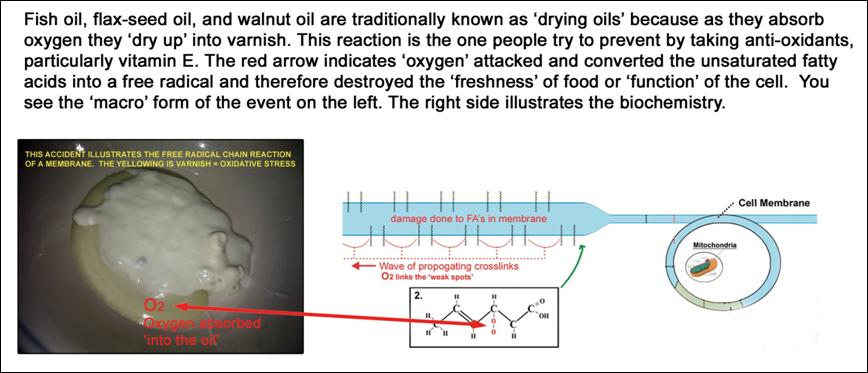
Going forward, many
lessons will show images of various phenomena you have seen or experienced in
the outside world and match these to the identical phenomena occurring in the
body as a bridge to understand how the body works. It is important to
realize much of what we know about how the body works resulted because we first
discovered how a process works in nature, and afterwards found out the same
event happens in the body.
The next section compares muscles, lighting, water, and brain cells. Women, athletes who need to develop explosiveness, and power lifters should understand the details in this lesson. The physical training techniques for getting stronger, faster, explosive – but not bigger, derive from applying the ‘electro-physiological’ principles in this lesson.
Lesson 4: Muscles,
Lightning, Brain Cells and Water
Part I: Usain Bolt,
Electricity, Potassium, and High Intensity Muscle Contractions
Analogizing and comparing two different things often helps you understand the one thing you really need to understand. For example, this section compares different tissues of the body to one another, specifically brain to muscles. It may not seem like it now, but comparing the two provides powerful insight into principles of strength training, nutrition, and more.
A ‘tissue’ is simply a specific body
part made up of particular cells.
In other words, a group of cells ‘clumped’ together into an organized fashion
make up a tissue. A specific tissue must function a certain way, like a
fist-sized group of muscle cells contracting and pumping blood 24/7. Obviously,
I just described heart tissue. Other tissues include brain, kidney, ovary,
bone, prostate gland, etcetera, but keep in mind cells of specific tissue
perform a specific purpose. For example, pancreas cells secrete insulin, ovary
cells secrete estrogen and progesterone, and nerve cells send electrical
signals.
Activating cells within a muscle or
your brain resembles lightning ‘sparking’ within a thundercloud supercell. Below: two
photos extracted from a video I took on my
cell phone while steering clear of a tornado, headed eastward, south of I-80 in
Nebraska, June, 2010.
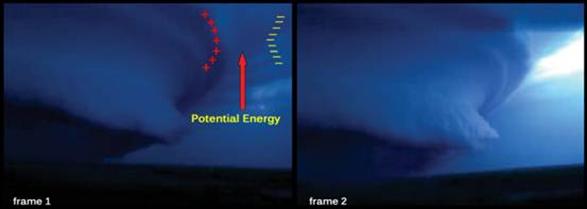
The next
several sections show how muscles and brain cells work ‘electrically’ through
combining photos
of a gigantic storm cloud with images of similar phenomena occurring in the
human body.
The graph below shows potassium forced out of a muscle during repeated bouts of 1 minute of high intensity exercise. The moment lightning lights the sky (in frame 2 above) is analogous when the electrolyte potassium ‘shoots out’ of a muscle cell, graphed below.

This
video demonstrates throwing common table
salt (Na+ CL-) onto fresh frog legs ‘spark’ the electrical twitch of muscle
cells. A muscle
activates or ‘twitches’ as electrolytes pass through the exposed surface and
into the muscle cells. We could also make a frog leg twitch by applying an
electric current directly into the muscle with an electrode. Imagine the
force produced by your muscle analogous to either a small or large stroke of
lightning. The magnitude of the force
produced by a muscle increases proportionally to the amount of ionic flow.
If salt could be thrown on all the cells 3-dimensionally throughout the leg –
and not just the surface of a few exterior cells – a more forceful twitch would
occur. The ‘muscle twitch phenomenon’ or ‘action potential’ was once taught
traditionally in high school biology classes by applying small or larger
amounts of electricity to the frog leg to make it twitch either weakly or more
forcefully. Sodium, potassium, calcium, and magnesium have the same effect as applying
elctricity directly with an electrode. This explains why we call these minerals
electrolytes.
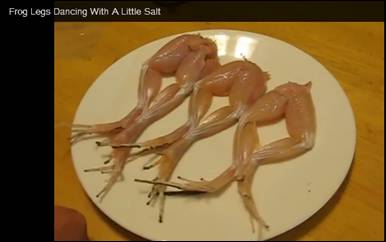
Normally,
the time frame of a lightning strike or potassium discharge during a single
muscle twitch lasts only for milliseconds. This means both cloud cells and
muscle cells quickly ‘relax’ and return to their resting state. At rest, each
cell is potentially ready to ‘spark’ a new discharge. However, in the case of a
constantly working muscle, potassium discharge continues unabated. This
explains the rapid release of potassium, graphed below during 1-minute of high
intensity exercise. In this case the cell does not relax; it stays ‘excited’ as
potassium rapidly discharges out of muscles into the blood stream (labeled arterial plasma, middle frame below).
Potassium levels return to ‘normal/resting’ levels after 4 minutes of rest.
Extremely high potassium levels in the blood stream can stop your heart from
beating. For example, Lee Harvey Oswald died not directly from his gunshot
wound, but from excessive potassium released into his blood, which lead to
cardiac arrest. Read this article, by Ray Peat to see his
explanation.

You just learned an ‘imbalance’ of
the electrolyte potassium can ‘arrest’ your heart beat. But the overall lesson is
electrolytes constantly flow into and out of your cells in a never ending
‘balancing act’.
Contracting your muscles cause a
momentary ‘imbalance’ of electrolytes as cells ‘activate’ but then should
‘rebalance’ on each side of the cell membrane as cells ‘relax’… all as quick as
lighting. Magnesium
relaxes the body by relaxing your muscles
electrically. Calcium ions make your
muscles ‘twitchy’ and when you die, calcium leakage permanently contracts your
muscles as if posing like a body builder. We call this rigor
mortis. People
commonly take magnesium to regulate their heart beat in the sense the heart must
‘relax’ effectively in order to ‘beat’ effectively. The heart is electrical,
muscle are too. Muscles produce ‘more power’ similarly to the heart when
properly relaxed; the key to a ‘fast muscle’ is a relaxed muscle. See Olympic
100meter dash sprinters express exactly this in this video.
‘Normal’ physiology, health of blood
and cells, and water balance are regulated by electrolytes. Magnesium
is difficult to obtain comparatively to sodium, potassium and calcium.
Potassium and magnesium deserve more attention, comparatively to calcium and
sodium.
In a human cell, flow of
electrolytes, water, and all nutrients is a two-way street, so imagine ‘ebb and
flow’ like the ocean tide. Essentially,
salty water stuff moves back and forth in cycles.
Next, we
examine what happens when the balance of electrolytes becomes ‘unbalanced’
within the watery medium surrounding cells.
HEADLINE: Jennifer Strange,
28, died Jan. 12, 2007 of water intoxication, or hyponatremia, after drinking
more than 1.5 gallons of water while taking part in a "Hold Your Wee for a
Wii" contest.
An overflow of water into her brain cells killed her. The next few sections illustrate the ‘ebb and flow’ of water and electrolytes into and out of cells of the human body.
http://www.onpointnews.com/NEWS/Radio-Stunt-Contestant-Had-Role-in-Own-Death.html

First, we compare the similarity of
a thundercloud and the transfer of ions within a supercell and a human cell. Ions have plus or minus charges
whether dissolved in water/blood or suspended in air. In frame 1, ions in a
thundercloud supercell build up, establishing a ‘static
electrical potential’. Then a ‘discharge’ of ionic flow lights the sky and
‘activates’ the cloud cell, frame 2. The cell ‘relaxes’ into darkness, frame
3.
The lightning ‘flash’ is analogous to the moment K+ (potassium) is
rapidly discharged out of a cell during 1 minute of intense exercise.

In a human
cell, electrolyte exchange is only ‘half the story’ of activating a cell; water
is ‘pulled’ simultaneously into a cell as it activates. Remember, movement of ions or salt into a muscle cell
makes it twitch or contract, as seen in the frog video. But what you did not
see is water moving into the cell as ions move.
Normally,
water immediately moves back outside the cell as it relaxes. In other words,
the balance of electrolytes on each side of the cell returns to their ‘normal’
resting concentrations. More specifically, after stopping exercise, water moves
outward from muscle cells to ‘calm’ and relax the muscle; electrolytes also
flow back in/out to their ‘normal’ respective positions/concentrations.
However, ‘overly sustained’ exercise or chronic overuse ‘pulls’ water into
cells – and tends to keep water from
leaving cells even after stopping exercise. This explains why chronically
fatigued nerves and muscles ‘hold water’.
An extreme
form of ‘cells holding water’ explains what killed Jennifer Strange as
illustrated below.
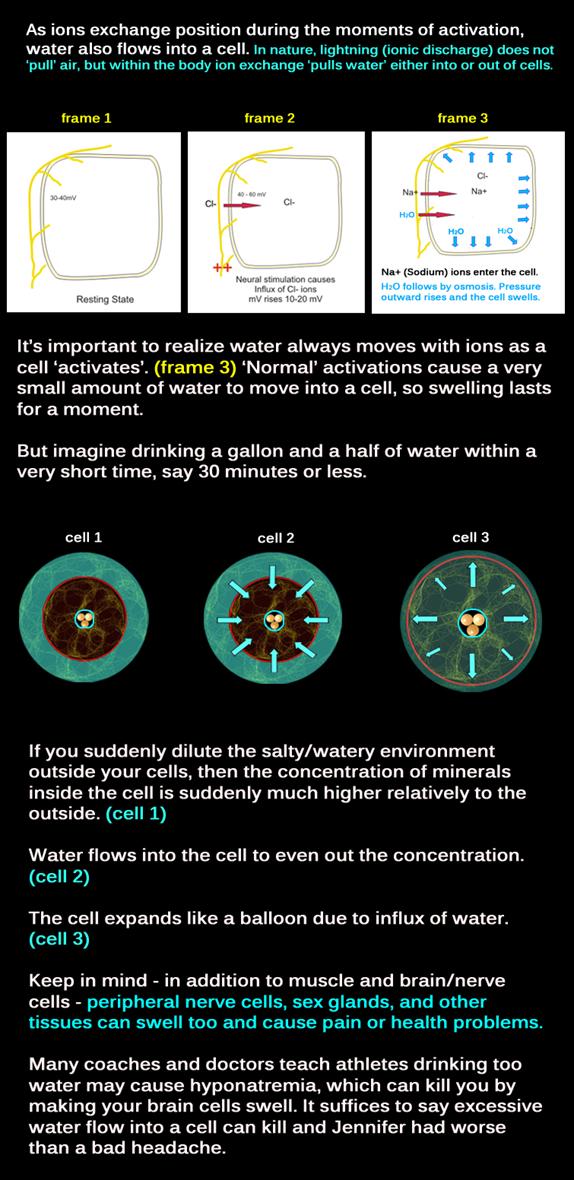
Notice
in frame 2 above, chloride (not calcium) triggered the cell; in this case the
cell of a gland, not a muscle cell. This serves to show particular cells use
different ionic ‘triggers’. Calcium ions trigger muscle contractions, which
explains why rigor mortis occurs after death. Water and ionic flow occurs in
all cells, not just muscle, brain, or peripheral nerve cells. For the record,
the creator of this sketch annotated it, Illustrating mechanism for
transportation of water and electrolytes across epithelial cells in secretory
glands. See the original sketch; click here.
Part
II: Relaxation vs. Excitation (or ‘Action Potential’)
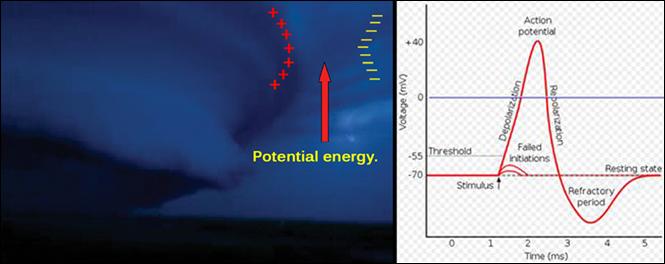
The ‘official’ way to graph a muscle’s electric potential, shown next to the thundercloud isn’t compatible with the way physics is classically taught or with the humans perceive ‘positive and negative’ with respect to flat ground, (i.e. high above ground = positive and below ground = negative). The next section corrects this problem.
First, the
‘official’ way to graph action potential above misleads people to think
“potential = action” by labeling the peak of the red line ‘action potential’. The cell has
‘potential to take action’ where the red line is flat, at -70mV. This is when a cell is in the rested
‘polarized state’ – relaxed. At -70 mV you are doing nothing, akin to a battery
not cranking the starter when your car engine is off or to a ball resting on
the edge of a hill ‘waiting’ to get pushed and roll down the hill. In classical physics, potential never
represents action. For example, height of a hill represents potential
energy not the action.
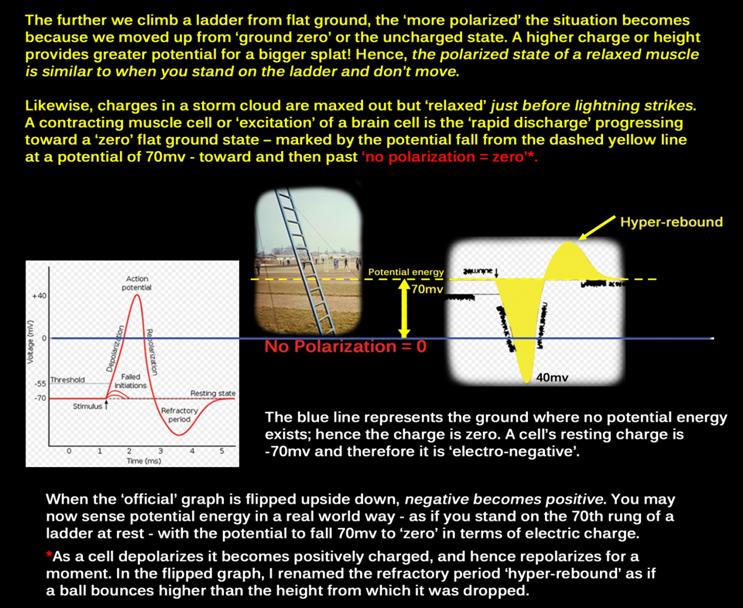
We sense
things fall downhill, not up. But since electrical charges are arbitrary, scientists
classically plot negative charges below zero. Hence, the maximum potential
energy is at the bottom of the graph at -70mv. But in the ‘fixed’ yellow to the
right of Earth -70 is now ‘up from zero or ‘flat ground’. Further, as a cell
‘depolarizes’ it becomes positively charged for a moment and hence repolarizes
in the opposite direction. This should
be termed ‘moment of action’ as opposed to action potential. Then there’s a
refractory period. I renamed this ‘hyper-rebound’ in the fixed yellow graph.
Discharge, refractory periods, rebounds, hmm… double entendres!
Chronic
fatigue and stress is synonymous with ‘overexcitation’ of your body (cells).
Imbalanced
electrical forces, i.e. imbalanced electrolyte flow keep cells activated and
prevent them from relaxing. Water moves concomitantly with electrolytes and is
‘held’ in place by electrical force. Water held in a cell is a reflection of
overstimulated swollen cells. Chronic excitation is synonymous with a
fatigued cell – nerve or muscle. ‘Globally’ speaking - in terms of your whole
body - chronically excited cells are simply fatigued cells, whether they are
nerve, muscle, brain, or prostate gland cells. Overhydration = excessive water
maintained or ‘held’ inside a cell.
Inflammation is: “swelling of a cell or entire ‘compartment’ of tissue.” For example, an enlarged heart is a
swollen heart; all the muscle cells have ‘swelled’ similarly to the
inflammation you see on your skin from a mosquito bite. It is no coincidence
that an enlarged heart is a failing heart – a fatigued and swollen heart –
deprived of energy or incapable of using energy because it has been
overstimulated and ‘tired’. At the micro level, overexcited nerve cells in the
wrist may swell, which causes pain associated with carpal tunnel syndrome. An
underactive thyroid or hypothyroidism can cause nerves to swell. Obviously,
realizing how such connections exist requires further study.
Generally, we do not sense low
levels of inflammation or ‘excitation’. The degree to which inflammation may be damaging or
healing the body, depends on whether it is an acute short term response or
chronic condition. We readily notice high level, acute responses of swelling
such as a mosquito bite or severe ankle sprain. Water just gets ‘shoved around’
from one space to another and expands the cells – or may leak out of the blood
stream into the space around cells. You can learn to feel low levels of
inflammation, which is wise if you are an athlete who wants to avoid injury and
overtraining. Discover how by asking questions.
Electrophysiology is the key for
understanding strength training, pain, inflammation, and the immune system. Once you visualize the division
among spaces and parts within your body - health and function all comes down to
nutrients, ions, and water moving from one compartment to another. Water and
ions remain suspended in position or ‘held in check’ by electrical repulsion
like 2 magnets repelling one another. Water and ions constantly flow across
space from one compartment to another when a disturbance occurs. You are alive,
so disturbance is the norm.
You disturb the resting ‘ionic
state’ of a muscle when you move.
Unlike any other cell, you control muscle cells, so you control the electrical
force and the power or strength applied. Essentially, examining flow of water
and the ions, sodium, potassium, calcium, magnesium, and chloride into and out
of a body part is a gateway for concretely understanding fatigue, injuries,
diseases, and many problems with the body. And where there’s a gateway, you
often find a simple solution to the problem. To learn more, read Ray Peat’s
article Water: swelling, tension, pain, fatigue, aging. http://raypeat.com/articles/articles/water.shtml
Mineral balance goes hand in hand
with water balance. Hydration is controlled by minerals. Water flow ‘obeys’
electrolyte balance. Electrolyte drinks are ‘supposed to’ maintain
mineral/water balance but usually provide too much sodium and not enough
potassium.
This
section was just an introduction to the purpose and wisdom of comparison,
metaphor, and analogy. It is not only helpful to compare different types of
cells to one another such as brain cells to muscle cells – it is also useful to
analogize a lightning bolt to the ‘spark’ of a cell as it relaxes or ‘gets
excited’. Linus Pauling called minerals the ‘spark of life’ for a very good
reason, because it is so. Static
electric force is a ‘physical force’ we humans can learn to manipulate for
improving the health of our blood and cells.
Analogizing
or comparing two different things often helps to better understand the one
thing you really need to understand. Making connections is the key to building
an integrated view of the whole.
Lesson 5: Fermentation and the Origins of Energy Balance Experiments
No doubt, it’s strange to hear for the very first time, “Fermentation is occurring right now within your intestines and muscles.”Probiotics or bacteria are tiny
organisms that transform carbohydrate into a variety of acids.
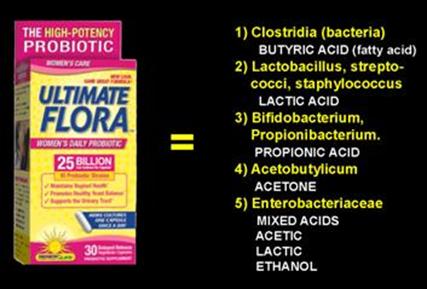
The yellow text above lists the
bacteria living in your intestines, including some that live in your mouth. The white text represents the
‘poop’ produced by bacteria after feeding on carbohydrate. One man’s waste is
another man’s treasure; these ‘wastes’ benefit your health and immune system
because acids are antimicrobial.
Lactic
acid is just one of several acids produced within your gut. The sharp distinctive taste in
yogurt, kefir, and buttermilk is lactic acid. Lactobacillus is the ‘live active
culture’ or bacteria commonly listed on a yogurt label. Lactobacillus ferments
sugar in milk into lactic acid.
Notice streptococci also ferments
sugar into lactic acid.
‘Strep’ is always present in your mouth in low amounts, ready to feed on sugars
you eat. Between visits to the dentist this bacteria multiplies and builds up
into the plaque (or biofilm) that accumulates on the border of your teeth and
gums, unless you decide to scrape it off by yourself. Bacteria live in many
places on our body and regularly buildup into a bacterial community called
biofilms, e.g. mucus like coatings on the trachea, vagina, prosthetic metal hip
replacements, and slime on teeth or rocks in a stream. Biofilms can be
beneficial or harmful, just like ‘good’ or ‘bad’ bacteria.
Frame 1 below shows the monthly
alteration in the vaginal biofilm community that corresponds to menses each
month. Frame 2
shows biofilm coating a platinum wire, similar to the growth on metal hip
replacements. Frame 3 shows the biofilm living in the appendix, readily
available for release into the proximal colon if ‘good bacteria’ populations in
the colon need ‘help to replenish’ or fight infection. Notice the word ‘mucin’
in frame 3, similar to mucus, which builds up in our throats and nasal passages
when we fight infections.

Many other important lessons on
nutrition and exercise science require knowing where gut flora live within the
intestinal tract in cows and humans.
For example, if greater numbers of bacteria lived in the upper section of the
small intestine, we would absorb much less calories due to bacteria consuming
food before we could absorb this energy into our blood stream. Weight loss and starvation
would result. As shown before, the darker shaded areas correspond to higher
population density of gut bacteria and higher rates of fermentation.

As shown in
lesson 1, carbohydrates ferment into lactic acid within the ‘bacterial section’
of your muscle cells. Below: A student’s hand drawn ‘muscle cell’. The cytosol of the cell
is labeled ‘bacterial region’.
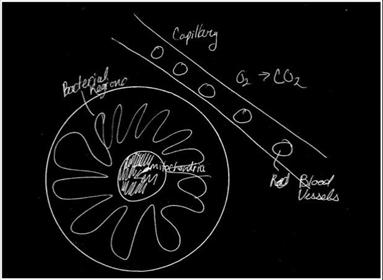
In the early 20th
century, the language used to describe physiology and nutritional events was
the same as describing natural, familiarly known physical phenomena. For example, aerobic metabolism and
respiration was referred to as ‘combustion
of food stuffs’ as if burning wood or coal. This crossover mentality
resulted in experiments and their subsequent description to be congruent with
the common man’s perception. Moreover, it was unnecessary to tell people they
were learning some sort of special ‘integrated form’ of nutrition. Below, milk
burns in a locomotive firebox similarly to combusting food stuffs within a
human muscle cell. When combusted, energy in milk converts to heat, within our
body or in a firebox.
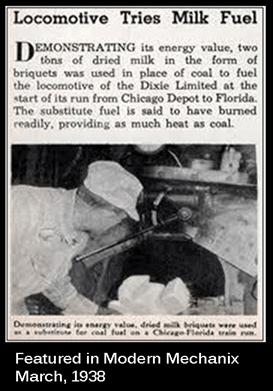
The common man’s
psyche and the physician’s education once developed from common roots –
language and experience wise. Consider the fact over 90% of Americans once farmed. Most people
understood fermentation and fermented foods, directly from experience. For
example, farm children carried buttermilk into the kitchen after milk
fermented. People learned through smell, taste, and touch; many things grown
ferment. Icky, smelly stuff was part of the home environment. Using a
historical perspective, we see why scientists used the word ‘fermentation’ and
why virtually everyone – even children – would not be completely baffled by the
scientist’s statement, “Muscles ferment carbohydrates into acid during high
intensity exercise.” Tell kids the acid in muscles is the same acid that
produces the distinctive taste in yogurt, buttermilk, and specific other foods
and they got the idea transformations in the body mirror transformations in
nature. Child or adult – it is not important or necessary to examine the
details of the chemical reaction at first; it is more important to realize
connections.
In such an
early stage of scientific exploration when scientists, educated people, or
farm-raised ‘uneducated’ folks remained connected by words and experience, most
anyone could concretely understand scientific descriptions of how the body
works. But
when modern scientists and writers living in a fragmented age of specialization
no longer themselves know the natural phenomena or the words to make useful
comparisons, then an integrated view of the world diminishes. Strict
definitions are practically useless in the early stages of learning. For
example, ‘glycolysis’ - defined as the
splitting of glucose into pyruvic acid - provides no sensible or contextual
meaning to a person. But when people learn sugar in grapes ferment into alcohol
(wine), probiotics in the gut ferment sugar into acids, and muscles ferment
sugar into acid too, the entire physical world becomes a cohesive picture that
makes ‘more sense’.
As words like
fermentation and combustion were abandoned through the 20th century,
new terms, new foods, new perceptions, and new science degrees were
concomitantly created. Glycolysis replace fermentation, margarine replaced butter. The
rise of the exercise physiologist, nutritionist, and athletic trainer coincided
with industry growth, technological advances in medicine and sports, and
mounting pressure on kids to play a single sport year round.
Throughout
the 20th century companies like the Newfoundland Butter Company,
General Mills and Pillsbury spawned a cornucopia of supposedly new healthy
foods like margarine and low or no-calorie foods through the creative powers of
the food scientist. Coincidentally, the general practice MD and celebrity pitchmen
like William Shatner espoused the promise of margarine
and the heart-health
benefits of trans-fat laden ‘manufactured oils’. Hydrogenated fat became suitable for the Betty
Crockers of America who loved baking pies and were convinced not to use lard or
butter. New paradigms replaced old paradigms. The food pyramid replaced the
four food groups. Clever ways to follow new rules were devised to fit with how
new foods ‘worked’. Dietitians and other institutional lackeys dispense advice
based on guidelines and pyramid schemes, created not by competent scientists
but by big government and lobby groups. Now we have food engineers, fish and
flax-seed oil, aka linseed oil or varnish, and GMO’s.
Viewing the
way food actually works within the human body - based on physics - became
obfuscated by redirecting people to focus on the possibility and fear of
acquiring ‘negative health outcomes’ based on risk factors. Eating to
prevent disease became a ‘lifestyle’ aimed to avoid the spectre of harm
associated with risk factors and supposed genetic pre-determinism - as opposed
to intentionally ‘eating to promote health’ based on how foods and environment
change expression of genes after we are born. People aim to not hit the
tree or avoid the water when teeing off. Fear
is the motivator; avoidance of sickness or the hazard, as opposed to communing
with physical regeneration or the fairway is a goal for many people. Epidemiology
the dirty
science
became the ‘gold standard’ for medicine and for creating guidelines of
nutrition. The divorce between physics and medicine was filed for decades ago.
As a result, fat or oil – the main fuel for the body – is no longer recognized
as ‘healthy fuel’ for the body.
Fat and oil are two words used to
describe the same substance. For
example, just because vegetable oil becomes solid via hydrogenation does not
mean it is no longer ‘oil’. We just
call oils ‘fat’ just as we call ice, ‘ice’ – not water – in order to clarify
our physical perception. Muddying the waters further regarding the perception
of ‘healthy fat’ is the fact oils used
for varnishing wood and seasoning cast iron pans, e.g. fish oil and flax-seed
oil now sell in health food stores. Traditionally, these oils are called drying
oils because they react with oxygen and ‘dry up’ into varnish. Researchers call
these fats ‘anti-inflammatory’ but may fail to realize this is synonymous with
suppressing the immune system. Anti-inflammatory oils, like cortisone
injections for injured athletes may be good for short term relief, but not for
long term health and healing. This writer knows these statements may bewilder
‘educated’ modern thinkers because he too stood in other shoes and did not know
the physics, chemistry, or history of
oil, metabolism, and physiology. In order to gain a clear understanding of
the present situation it is wise to examine original research.
We digress.
Winding back the clock to the late 1800’s we see nutritionists and exercise
scientists did not exist in name but did in practice, as formally trained
chemists, physiologists, and physicists. And if we return to a point in
time where nutrition and exercise science in its modern integrated form
originated, we see one man named W.O. Atwater, an
agricultural chemist.
A cursory look at the words Atwater
to describe food, calories, energy, and regeneration of the human body
demonstrates ‘straight physical talk’. “Food may be
defined as material which, when taken into the body, serves to either form
tissue or yield energy, or both. This definition includes all the ordinary food
materials, since they both build tissue and yield energy. It includes sugar and
starch, because they yield energy and form fatty tissue. It includes alcohol,
because the latter is burned to yield energy, though it does not build tissue.
It includes creatin, creatinin, [sic] and other so-called nitrogenous
extractives of meat, and likewise caffeine of tea and coffee, because they
neither build tissue nor yield energy, although they may, at times, be useful
aids to nutrition.” W.O. Atwater: 1905, pictured below.

Even non-scientist writers from the
past described the physiology of weight loss and thermodynamics in a ‘superior
scientific way’ compared to modern
scientists and writers.
For example, read chapter 1: Preliminary
Bout in a book written by Lulu Hunt Peters in 1918 – click
this link. She uses
the term ‘fireless cooker’ to describe the lack of heat loss in people who have
trouble losing weight, which is not only brilliant, but also explains why so
many modern scientists fail to understand the fundamental physics of weight
loss and calories. Studying physics is not primarily about examining the
origins of the universe; it was and still is simply studying anything and
everything physical, human body included. The word physician derives from the
art and science of practicing physics. To ‘take a physic’ once meant to swallow
medicine. ‘Physical training’ is practicing physics. The study of physics,
exercise science, and nutrition were one and the same to the seminal
researchers from
the past.
Look no further to seek the seminal research. The next
section shows photographs from the ‘original energy balance experiments’ and
briefly describes the essentials of metabolic science and exercise physiology.
This is to warm up to examining nutrition and exercise science in a new, ‘old’
way.
Now we have
traced back to the origin of energy balance experiments. The photo
below resulted from experimental studies on food and humans conducted by Atwater
and Benedict in the late 1800’s and early 1900’s. By 1906, Benedict, a
physiologist and magician mastered the modern technique use to calculate the
quantity of carbs and fat burned by the body during rest or exercise.
This man exhaled into a mask in
order to collect the carbon dioxide (CO2) expelled from his lungs with each
breath. The
scientists Atwater
and Benedict compared the
volume of CO2 expelled to the volume of oxygen he consumed in order to quantify
carbohydrate and fat used by his body at any intensity level.
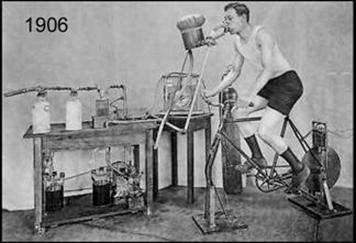
Still to this day, you must wear a mask to measure the volume of oxygen breathed and the carbon dioxide breathed out.
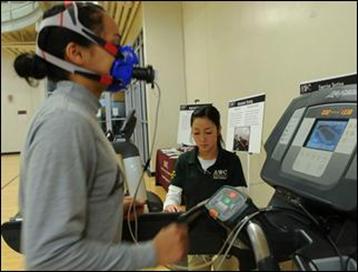
Comparing
the volume of one gas breathed out (carbon
dioxide) to one gas breathed in (oxygen)
is called the Respiration Exchange Ratio or RER for short. This is expressed in
a ratio: [CO2/O2] The reason why RER exists is absurdly simple. Our cells
consume O2 and then we blow out CO2. That’s it.
Within a muscle cell (or any cell) the chemistry of respiration is
essentially a slower form of combusting a log in a fire. The chemical reaction in words is: Fuel combines with
oxygen and produces the waste products CO2, H20, and Heat.

Practically
all children learn the physics of creating fire. Do we not tell children,
“throw some fuel on the fire!”?
Calories were once called ‘Atwater Factors’. For a time his name was synonymous with the word calorie. Atwater’s calculations of the energy content of food made it possible to quantify how much energy humans used in terms of calories in and calories out.
Below is
the actual copy from a popular magazine called New Century where the word
‘calorie’ appeared the first time ever
in American print; published
1887. He indicated the heat contained in food (in calories per gram) for
carbohydrate, protein, or fat as we know it today. Approximately 4 cal/g for protein and carbohydrate and 9 cal/g for fat.
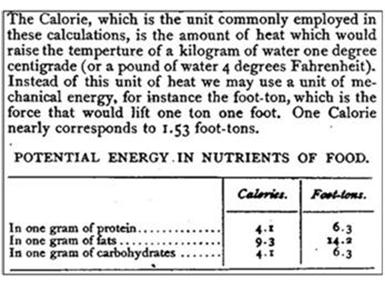
Hence, the
modern ‘Nutrition Facts’ label and modern listings for energy content in food
derives from experiments calculated by Atwater, indicated as ‘fuel values’. The
data below is still used today by commercial enterprise because it’s accurate.
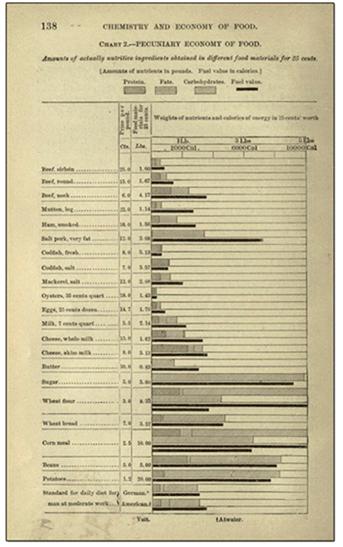
Atwater was
paid $7,500 (in early 21st century money) for each single article,
(in a series of five articles) named The
Chemistry of Food and Nutrition.
Imagine not
ever hearing the names Isaac Newton or Albert Einstein when it comes to even
the most casual learning environment on gravity, physics, light, or the
universe. By casual, I mean just sitting around the campfire and musing over
gravity, god, or existence while star gazing or trash talking to put someone
down, “You ain’t no Einstein.” My point is omitting Atwater and Benedict’s
names from the curriculum of any modern medical, nutrition, or exercise science
exercise/sports science field (where you need to learn the most essential
things like force, food, power, calories, speed, and energy) is equivalent to
omitting Newton and Einstein from the books and lectures of the physics world.
Keep in mind physics is the root word of physician and physiology.
Atwater’s human metabolism
experiments were considered to be the dream project for the 19th
century; he was perhaps the most famous scientist in the U.S. during the late
1800’s. However,
some of the earliest metabolic experiments on humans were conducted in the
1770’s by Antoine Lavoisier. (Lavoisier later lost his head to the guillotine.)
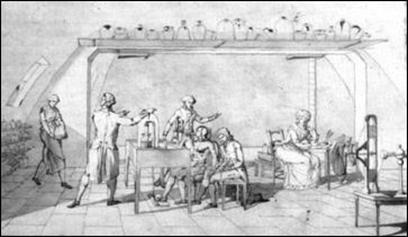
Flash forward back to the 21st
century. Gut flora education, probiotic supplements, and fermented drinks like
kombucha have made a comeback.
Although many people eat bacteria for health reasons, many people do not
realize bacteria need to eat and do not realize properly feeding gut bacteria
is more important than eating bacteria directly.
Bacteria do not eat themselves; they
eat sugar or ‘prebiotics’. If you have a healthy and vigorous gut flora
population, taking a probiotic supplement is as powerful as a fart in a
hurricane. You are just adding a tiny fraction of bacteria to the billions
already there.
Bacteria and muscle cells ferment
carbs into acids at all times;
this is why lactic acid is always present in our blood in small amounts at rest
and high amounts during high intensity exercise.
High intensity exercise is just
fermentation speeded up within a muscle, as cells have a feeding frenzy on
sugar.
The present
often circles back to the past. Atwater and people in his time used the word
‘ferment’ to describe muscle metabolism. Now we do too. Using this word is more
sensible because it paints a more physically coherent picture in terms relating
‘like events’ occurring within guts, muscles, a beer fermentation vat, or
anywhere else within or on your body where bacteria live and eat.
As we go
forward, we’ll continue to use words and imagery to build a greater picture.
Lesson 6: Linear Perception vs. Perceiving ‘Simultaneity’ (Image to Imagination)
The purpose of this section is to
realize how words and imagery manipulate the perception of time as a teaching
tool.
Western
minds are generally conditioned to think in ‘action form’ through imagery and
words – specifically in linear sequences where time appears to flow from the
past to the future. The comic strip and a film strip both consist of ‘time
flow’ action panels.

Writing
in active voice and communicating via
linear time-based images prevent your brain from perceiving two different
physical phenomena that are actually the same event. It is difficult to
understand this in words, so I’ll use images to convey these ideas.
Anyone
knows two different things can occur simultaneously. For example, you can laugh
while your little brother cries. Each is a different physical phenomenon and
there’s no doubt they could occur at the same time.
It
is difficult however, for the brain to perceive two different physical things
that are actually the same event. In this case, the only way each physical
thing can be shown to describe one event is if and only if they occur simultaneously.
You have already been shown images that accomplished the task. You just haven’t
been made conscious of what you’ve seen. Now is the time.
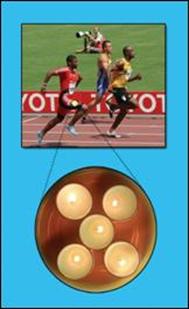
External movement of
your whole body and unseen metabolic events in your muscle cells occur
simultaneously. The two physical phenomena shown above (running and fermentation)
do not occur separately with respect to time. The only way to see this is to
‘freeze time’ and show at least two images that actually represent the same
event taken as a whole. Described more specifically in words, “What happens
microscopically and unseen within the body’s cells at a specific moment
synchronizes with its simultaneous but
different physical-form.” To say each form or phenomenon is a different
event is not correct because taken as a whole it is/they are the same event.
In other words,
functional nutrition and physical movement occur simultaneously.
Hardly
anyone thinks of nutrition as an event, in concrete terms. However, people
often speak of ‘metabolism’ as an event that has a concrete outcome such as
weight gain or weight loss. Such an outcome can only occur because functional nutrition is metabolism. Nutrition is an active
event. (Duh! Duh – as in epiphany.) In all three cases below, you ‘see a cell’
fermenting carbohydrates joined to its other
simultaneous external form, as seen
by the naked eye. Keep in mind, resting must be considered as part of the
whole.
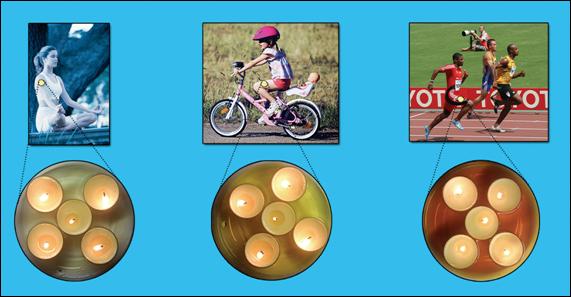
Perceiving simultaneity
is not limited to just two forms; we feel other ‘simultaneous counterparts’
(e.g. pressure in joints, muscle tension, pain or exhilaration) as we
experience the movement of our bodies or the release of stress that comes with
deep breathing and the slowing of our heart rate. The image of the woman
sitting peacefully captures such a moment in time.
If
you have ever heard anyone say, “I can feel down to the cellular level”, then
this lesson shows you how it is at least possible to begin connecting with your
body in such a way. You can learn to feel your ligaments and tendons – safely –
in such a manner that you are ‘your own
MRI’. I will be teaching this later this semester. You want integrated education?
You got it.
In short, either clumsy or athletically skilled movement occurs in concert with our ‘emotional content’ as well as chemical transformations of matter in the microscopic ‘cell space’ of muscles. See the beginning of Enter the Dragon with Bruce Lee to understand what I mean by emotional content. (or ask me)
Passive Voice vs. Active Voice, Imagery, and Conditioning
Usually, non-fiction writing calls for using ‘active voice’. But Passive voice should sometimes be used deliberately as a device to ‘force’ the reader to focus solely on an object, as opposed to a person or thing taking action and imposing change upon an object. For example, earlier I wrote in passive voice, “Acid is always created in a cell” as opposed to, “Cells always create acid” (active voice). I wanted you to focus on acid, not on the cell taking action. Consider this in light of a ‘quick and dirty tip’ from a teacher on the topic of using passive voice vs. active voice, “One clue that your sentence is passive is that the subject isn't taking a direct action.” (Mignon Fogarty, Grammar Girl)
Active
voice (or a comic strip) presents a ‘problem’ when the purpose is to focus on
two physical phenomena that must be shown to happen simultaneously. For
example, I could write, “Muscle cells ferment carbohydrates into acids as the
runners sprint down the track.” You may understand this now, but this would not
make much sense to a person who has not yet learned each piece of the whole, as
shown in the earlier sections of this book. I sometimes used passive voice and
imagery to force focus on each object
independently. Passive voice and imagery work together; each portray
simultaneity and freeze time. The image below ‘freezes time’. When we ‘freeze time’ no action is taking
place, there is only the sense of what ‘is’ or things as they ‘are’.
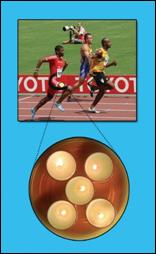
In
short, passive
voice mirrors the way our brains hold an image. People who like mysteries do
not mind the use of passive voice, because it leaves a person hanging on the
image, remaining clueless of who or what acted upon the object. Patient
curiosity trumps frenetic impatience. Conversely, action based writing, e.g.
Russell Wilson scrambles, evades a sack, throws on the run deep downfield to
Percy Harvin, Harvin leaps for the ball and runs in for the TD” are moving images of thought like a film
strip. Without question, images that make ‘time appear’ makes it impossible to
imagine ‘simultaneity’ of two different phenomena.
Without knowing it, our
brains are conditioned by linear-time action sequences.
Fortunately,
we can condition our brains to use words and imagery to imagine ‘simultaneity’.
This is harder for many Western people but not Japanese people because they are
culturally conditioned from an early age by images that depict simultaneity
from a young age; (see references and my remarks soon below on this thought).
You Can’t Imagine Unless
You Activate Your Image-In. (Imagination)
By
using words and imagery ‘passively’ I am often showing you to not think (but to just perceive and
develop an imagination, Image-I-Nation) Rhetorical question: Do you recall ever
being told or saying, “Learn it by Heart”. Clearly, this is a level that
indicates we know something so well we don’t have to think about how do it or
we recall the meaning or definition of something instantly.
Just
as there is no need to think after
you master the mechanics of a dead lift, singing a song, serving a tennis ball,
using a stick-shift, or playing a musical instrument, once you know what a
complex image shows, there is no need to think. Recall the advice and the
purpose of Video 1: Image Imprinting,
“I don’t want you to think, I want you to see, just watch the video.”
Even
though the images in this video transitioned quickly – they were not depicting
a linear series of images to tell a story – but flashed single images, which
are used in this book/class/seminar to synthesize a greater coherent whole.
Connecting images you know by heart, stored in your head, is a way to develop a
slower, but more powerful reasoning ability. As you read or come across new
information your brain automatically ‘conjures up’ images connected to the new
‘bit’. But you have to know what the ‘bits of the whole’ represent in order to
build the ever greater picture. I suggest you draw by hand to anchor your
ability to hold images and cement what you learn more deeply.
Developing an
imagination (the ability to picture things concretely) enables you to ‘see
connections’ of phenomena occurring outside
of the body in nature with ‘health phenomena’ occurring in the body. For example, the
yellowing of the bleu cheese dressing shown below shows oxygen combined with the unsaturated fatty acids in the soybean
oil. The whiter area was enclosed away from air (inside the turned upside down
jar) but the part that yellowed was exposed to air (oxygen) and so oxidized
overnight as it sat on my counter top!
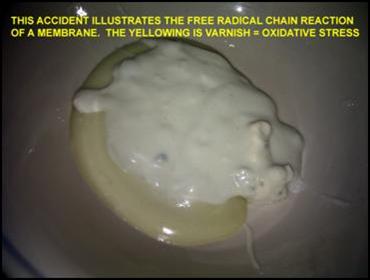
The
yellowing you see resulted from a free radical chain reaction, which occurs
readily to unsaturated fats in both
food and in your body. Polyunsaturated fats like fish oil, flax-seed oil, and walnut
oil are especially vulnerable to this yellowing effect and therefore harmful to
the body in technical terms, i.e. oxidative stress and free radical chain
reactions. The only way for oil based paint to dry and produce a quality
varnish is IF they are unsaturated fats. Saturated fats by definition are
stable and not prone to oxidation, yellowing, or varnishing.
If you take
anti-oxidants, you are trying to prevent oxidation or free radical chain
reactions from destroying your cell membranes, similar to the image above where
only the outer edge was ‘destroyed’. Moreover, this picture below explains why taking a purported
healthy product like fish oil as a way to promote something ‘good’ is a great
example of jamming a ‘bit of something
that is true’ into a larger incorrect medical model. Yes it’s true that
fish oil is anti-inflammatory, which = the true bit. But there’s a reason
‘overall’ why this effect is ‘not good’ in the long run.
Developing and
synthesizing an image base enables you to integrate knowledge within your head.
However, there are two points to remember:
Point 1: You just saw an example
of a harmful chemical reaction that happens in your body and in nature.
Point 2: It is crucial each
‘small picture’ (bit of information) is based on correct knowledge in order to
avoid a structure of thinking (a theory) that is invalidated by an incorrect
bit.
Comics, Communication, and Cultural Conditioning
I
am aware of the enormous difficulty to describe and conceive ‘simultaneity’. The way images are presented in the USA (and many others) conditions all
of us to perceive time and action in a certain way. I suggest reading Understanding Comics by Scott McCloud if you
want to wrap your head around this more completely. Below: excerpt to the
McCloud link.
Naturally,
McCloud presents the ‘simultaneity concept’ in
comic form to describe art, communication, and perception in his book. He
shows examples of how the Japanese in particular express multiple images that reflect
‘simultaneity’ more often than any other culture. McCloud did not use the word
‘simultaneity’ – this author takes credit for this -Whoop dee ding and yippee
kai-yay for me.
Keep in mind, the
illustrations you see throughout this course show the ‘simultaneity’ of micro
and macro events. Physics, art, medical science, and nutrition go hand in hand.
Physiology is physics and art, and art is communication. I actually draw the
concept of ‘action based linear perception vs. ‘perception of simultaneity’ in
front of live audiences when it’s practical to do so. Many early physicians
were artists. See Ray Peat’s article Painter
Science on this topic!
Studies of Embryos by
Leonardo da Vinci (Pen over red chalk 1510-1513)
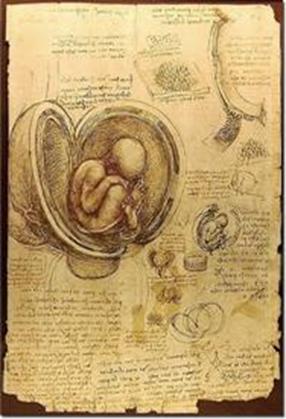
Art not only simplifies
health, nutrition and physical training science, but may be used to present
metabolism as ‘it’ actually is – one event occurring simultaneously – as opposed
to sets of incoherent, separate phenomena. Visualizing spaces within the body –
compartmentalizing it – similarly to visualizing the location and separation of
objects within in a space in your home such as your bedroom must be an ability
you develop if you want to master just the basics of health, nutrition, and
exercise science.
A
lot of details about nutrition, physiology, and health can be learned from a
single schematic showing the pathway food and oxygen take to get into the
blood, and then to muscles – as depicted below in a schematic titled: “The
Anatomy of Food and Oxygen Delivery”. (Lesson 8 from The Physical Rules by this author)
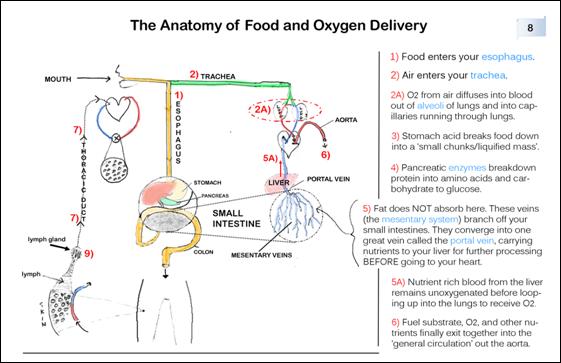
Lesson 7: Messages from Masters of Nature, Science, and Economics
Notice the
thread of common thought shared by the following people, even though each
work(ed) within a different field or century. (highlighted and
bolded).
ON DEVOLUTION OF THE SCIENTIFIC METHOD:
The last 50 years in the history of life sciences are remarkable for a new
important feature that looks as a great threat for their future. A profound specialization dominating in quickly developing fields of
science causes a crisis of the scientific method. The essence of the method is a unity of two elements, the experimental
data and the theory that
explains them. To us,
"fathers" of science, classically, were (are) the creators of new
ideas and theories. They were the true experts of their own theories. It is
only they who have the right to say: "I am the theory". In other
words, they were carriers of theories, of the theoretical knowledge. The
fathers provided the necessary logical integrity to their theories, since
theories in biology have not still to be based on strict mathematical proofs.
It is not true for sons. As a result of massive
specialization, modern experts operate in very confined spaces. They formulate
particular rules far from the level of theory. The main theories of science are
known to them only at the textbook level. Nowadays, nobody can say:
"I am the theory". With whom, then is it possible to discuss today on
a broader theoretical level? How can a classical theory - for example, the
membrane one - be changed or even disproved under these conditions? How can the
"sons" with their narrow education catch sight of membrane theory
defects? As a result, "global" theories have few critics
and control. Due to specialization, we have lost the ability to work at the
experimental level of biology within the correct or appropriate theoretical
context. The scientific method in its classic form is now being rapidly eroded.
The Purpose of Soil And Health Library: http://www.soilandhealth.org/index.html
The wisest student
learns from the originators of a body of knowledge because those who later follow in the
founders' footsteps are not trailblazers of equivalent depth. This is especially true of the writings from many post WWII academics
and professors who mainly write because they must publish . .
. or perish. Even when the earliest works in a field contain errors because
their authors lacked some bit of data or had a fact wrong, their books still
contain enormous wisdom. If nothing else,
study of older books lets
us discover that the conditions that prevail today aren't the way things always
were—whilst on some levels, some things hardly ever change at all.
Source and/or suggested readings:
1.Comparative Gut Microflora, Metabolic Challenges, and Potential Opportunities
J. Apajalahti Alimetrics Ltd, FIN-00380 Helsinki, Finland Download from Dropbox
The Processes of Death and Decomposition
By Farlander: http://h2g2.com/approved_entry/A2451683#conversations
Small Intestine: http://microbewiki.kenyon.edu/index.php/Small_Intestine
Some
of my Best Friends are Germs
Woman
Drinks Only Soda for 16 Years, Suffers Heart Problems
http://www.livescience.com/37707-excessive-soda-consumption-heart-problems.html#
*Other acids are also produced in a series of 10 steps as glucose converts to lactic acid. But for practical purposes we can assume only one is produced as far as a ‘primary waste product’ is concerned.
** If you are thinking, “wait a
minute!... ATP is used to power muscles,” then you need to realize ATP is not a
fuel substrate per se’, but the final and actual stuff that goes K’POW to make
a muscle contract. ‘P’ in ATP stands for phosphorous, which is the explosive
stuff on a match head you strike it to light it. We totally ignore ATP for now;
it’s ridiculous to teach the role of ATP in muscle metabolism (as most
textbooks do) before learning the more meaningful connection between the food
you eat and how muscles use food as fuel substrate.
***Even
thought ATP powers explosive movements without oxygen, ATP is not a fuel
substrate. Glucose and fat are fuel substrates used to produce ATP. Fermenting
glucose produces ATP much faster and in greater amounts than aerobic metabolism
of glucose.
****At
the turn of the 19th Century and throughout the first half of the 20th
century, glycolysis - the reaction that causes high intensity, anaerobic muscle
contractions - was called fermentation.
**** Not all bacteria are ‘obligated’ to
feed only on sugar/carbs.
1. Carbs are the primary fuel for
cells (invalid)
2. Saturated fatty acids increase
cholesterol (invalid)
3. LDL cholesterol increases risk of CHD:
(invalid, see slide below)
Coronary heart disease risk does not increase
significantly as LDL levels increase.
Obviously it is more important to maintain a high HDL
level.
Direct source: http://www.lipidsonline.org/slides/slide01.cfm?q=Framingham+Heart+Study
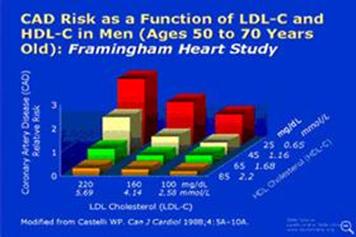
This
is a valid statement, but the recommendation to take fish oil ‘fits into’ a
thought structure based on wrong thinking. Fish oil is anti-inflammatory
because it’s immunosuppressive, duh. Suppressing
inflammation is synonymous with suppressing the immune response (as a cell swells when it is an excited state). Thus, the symptoms of inflammation
get ‘treated’ – giving the appearance a problem is solved when it is not by
quelling a symptom. This is analogous to the fact drugs treat symptoms but not
the cause of the underlying condition. I use this as an example to point out
the hordes of writers who regurgitate their source reading and spread wrong
information. This is normal; I am not criticizing it. I too once thought
certain fish and flax seed oils were ‘healthy’… before I understood
peroxidation, how to season a cast iron pan, free radicals, and the immune
system. What should be criticized is remaining obstinate or in disbelief after
examining indisputable evidence that may be contrary to a point of view.
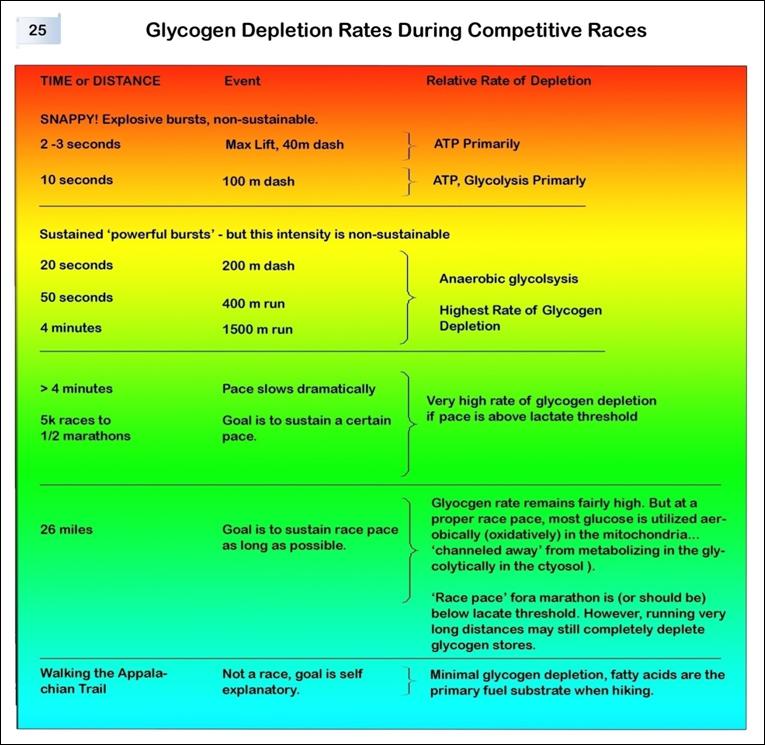
Graph 2 from Lesson
25:
